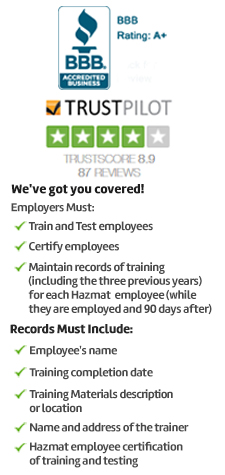
IATA DGR Class 5 Training

This course will make students understand the existing norms in safe transporting of hazardous substances through air carriers under the IATA Dangerous Goods Regulations, roles and responsibilities of cargo handlers and shipment operators and safe practices followed to check, identify, register, pack, mark, label, carry and load and unload of goods contain oxidizing substances and organic peroxides.
The course syllabus also has a module for Class 5 oxidizing substances and organic peroxides which provides learners a step-by-step approach and specific procedures for safe handle and transportation.
Governing regulations
Those who are engaged in Shipping Oxidizing Substances and Organic Peroxides by air must follow the IATA Class 5 Dangerous Goods Regulations.
This online course can be a proof of qualification and can train anyone who are associated with transporting dangerous goods, including FedEx and UPS.
Employees of shippers who are engaged in shifting other categories of dangerous goods via airplane should join our IATA Dangerous Goods Regulations training instead of this course.
Course Overview
Transporting Oxidizing Substances and Organic Peroxides by airplane follows IATA Class 5 Dangerous Goods Regulations. Hence the course syllabus includes all such requirements as part of training to those involved in handling dangerous cargoes, including FedEx and UPS.
Who Must Take this Course?
As per the rules of IATA DGR, specific training should be given and cargo handling skills verified periodically for workers as mentioned in Table 1.5.A, who include airline goods acceptance staff, transporters and shippers and freight handlers; goods development and training experts; Ground and load handling staff at various places, specialists who manage regulations, Operations and station officers and airport security managers.
Course Format
Our IATA Dangerous Goods Regulations Shipping Class 4 training and certification course provides well-researched content, graphics, audio presentations, huge practice questions and a final exam.
Once completed, all students will be provided with hard copy of completion certificate and can print a wallet card.
Continuing education credits?
Each student will receive 0.3 CEUs (or 3 CMEs) for completing this course.
Topics Covered
- About This Course
- Course Objectives
- Introduction to Dangerous Goods Regulations
- Philosophy of Dangerous Goods Regulations
- Key Terms and Concepts
- Dangerous Goods Incidents and Statistics
- How to Use the DGR
- Changes to the 59th Edition
- Applicability
- Basis of the IATA Dangerous Goods Regulations
- Application of the Regulations
- Shipper’s Responsibilities
- Operator’s Responsibilities
- Training
- Adequate Instruction for Shipping Section II Lithium Batteries
- Security
- Limitations
- Forbidden Dangerous Goods
- Hidden Dangerous Goods
- Dangerous Goods Carried by Passengers or Crew
- Dangerous Goods Transported by Post
- Operator’s Property Exceptions
- Excepted Quantities
- Limited Quantities
- Variations
- Classification
- Packing Groups
- Shipper’s Responsibilities
- Multiple Hazards
- Samples
- Identification
- Selecting the Proper Shipping Name
- Using the List of Dangerous Goods
- Packing
- Shipper’s Responsibilities
- Overpacks
- Salvage Packaging
- General Packing Requirements
- Specific Packing Instructions
- Packaging Specifications and Performance Tests
- Codes
- Markings
- Requirements for Inner Packagings
- UN Outer, Single, and Composite Packagings
- General Testing Requirements
- Types of Tests
- Test Reports
- Specific Testing Requirements
- Marking and Labeling
- Markings
- Labels
- General Label Specifications
- Hazard Labels
- Handling Labels
- Documentation
- Shipper’s Declaration
- Completing the Shipper’s Declaration
- Air Waybill
- Additional Documentation
- Handling
- Acceptance
- Loading
- Inspections
- Provisions for Pilot-in-Command
- Informing Passengers and Shippers
- Reporting
- Document Retention
- Class 5 Oxidizing Substances and Organic Peroxides
- Oxidizing Substances
- Organic Peroxides
- Classification
- Temperature Controls
- Desensitization
- Exceptions, Limitations, and Labels
- Packing Instructions
- Summary
- Additional Resources

 NEBOSH CERTIFICATE
NEBOSH CERTIFICATE NEBOSH DIPLOMA
NEBOSH DIPLOMA IOSH
IOSH SAFETY DIPLOMA
SAFETY DIPLOMA CPD UK
CPD UK ROSPA UK
ROSPA UK FOOD SAFETY
FOOD SAFETY 



